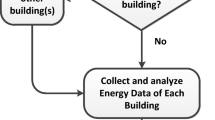Abstract
The simultaneous impact of massing on both energy consumption and renewable energy production potential is studied by taking the case of office buildings in Washington D.C. A Baseline design with a square footprint is compared with eleven massing alternatives: three rectangular parallelepiped designs with aspect ratios of respectively 2, 3, and 4, along the east-west orientation; three rectangular parallelepiped designs with aspect ratios of respectively 2, 3, and 4, along the north-south orientation; two H-shaped designs; one cross-shaped design; and two pyramidal buildings with wall slopes of respectively 86° and 83°. With differences between the best performing massing alternative and the worst performing massing alternative of more than 10% in terms of energy consumption, and more than 20% in terms of renewable energy production, massing is found to significantly impact both energy use and energy production. Consideration of both energy consumption and renewable energy production potential suggests that, for temperate climates such as Washington D.C., buildings with H-shaped footprints, buildings with crossshaped footprints, and buildings with high aspect ratio footprints are preferable when targeting net-zero energy status.
Similar content being viewed by others
References
ASHRAE (2007). Standard 90.1-2007 User’s Manual. Atlanta, GA: American Society of Heating, Refrigerating and Air-Conditioning Engineers.
ASHRAE (2010a). Standard 62.1-2010: Ventilation for Acceptable Indoor Air Quality. Atlanta, GA: American Society of Heating, Refrigerating and Air-Conditioning Engineers.
ASHRAE (2010b). Standard 90.1-2010: Energy Standard for Buildings Except Low-Rise Residential Buildings. Atlanta, GA: American Society of Heating, Refrigerating and Air-Conditioning Engineers.
ASHRAE (2013). Handbook of Fundamentals. Atlanta, GA: American Society of Heating, Refrigerating and Air-Conditioning Engineers.
Cheng V, Steemers K, Montavon M, Compagnon R (2006). Urban form, density and solar potential. In: Proceedings of the 23rd Conference on Passive and Low Energy Architecture, Geneva, Switzerland.
Chin N, Franconeri P (1980). Composition and heating value of municipal solid waste in the Spring Creek area of New York City. In: Proceedings of the 1980 National Waste Processing Conference, Washington DC, USA.
Compagnon R (2004). Solar and daylight availability in the urban fabric. Energy and Buildings, 36: 321–328.
Crawley D, Pless S, Torcellini P (2009). Getting to net zero. ASHRAE Journal, 51(9): 18–25.
Depecker P, Menezo C, Virgone J, Lepers S (2001). Design of buildings shape and energetic consumption. Building and Environment, 36: 627–635.
DOE (2015). A Common Definition for Zero Energy Buildings. Washington DC: U.S. Department of Energy.
EIA (2016). Commercial Buildings Energy Consumption Survey—2003 Survey Data. Available at http://www.eia.gov/consumption/ commercial/data/2003/. Accessed 05 Feb 2016.
EO (2015). Executive Order 13693—Planning for Federal Sustainability in the Next Decade. Federal Register, 80(57): 15871–15884.
EU (2010). Directive 2010/31/EU of the European Parliament and of the Council of 19 May 2010 on the Energy Performance of Buildings (Recast). Official Journal of the European Union, 153: 13–35.
Granadeiro V, Duarte JP, Correia JR, Leal VMS (2013). Building envelope shape design in early stages of the design process: integrating architectural design systems and energy simulation. Automation in Construction, 32: 196–209.
Gratia E, De Herde A (2003). Design of Low Energy Office Buildings. Energy and Buildings, 35: 473–491.
Hachem C, Athienitis A, Fazio P (2011). Investigation of solar potential of housing units in different neighborhood designs. Energy and Buildings, 43: 2262–2273.
Hemsath TL, Bandhosseini KA (2015). Sensitivity analysis evaluating basic building geometry’s effect on energy use. Renewable Energy, 76: 526–538.
Hirsch JJ (2014). eQuest v3.65. Available at http://www.doe2.com.
Kämpf JH, Montavon M, Bunyesc J, Bolliger R, Robinson D (2010). Optimisation of buildings’ solar irradiation availability. Solar Energy, 84: 596–603.
Kanters J (2015). Planning for solar buildings in urban environments— An analysis of the design process, methods and tools. PhD Thesis, Lund University, Sweden.
Marks W (1997). Multicriteria optimization of shape of energy-saving buildings. Building and Environment, 32: 331–339.
Masa-Bote D, Caamaño-Martín E (2014). Methodology for estimating building integrated photovoltaics electricity production under shadowing conditions and case study. Renewable and Sustainable Energy Reviews, 31: 492–500.
Mermoud A, Wittmer B (2014). PVSyst6—User’s Manual. Satigny, Switzerland: PVSyst SA.
Montavon M (2010). Optimisation of urban form by the evaluation of the solar potential. PhD Thesis, Ecole Polytechnique Federale de Lausanne, Switzerland.
Norton B, Eames PC, Mallick TK, Huang MJ, McCormack SJ, Mondol JD, Yohanis YG (2011). Enhancing the performance of building integrated photovoltaics. Solar Energy, 85: 1629–1664.
NRCan (2013). RETScreen v4. Varennes, QC, Canada.
NREL (2015). System Advisor Model v 2015.6.30. Available at https://sam.nrel.gov.
NREL (2016). Best Research-Cell Efficiencies. Available at http:// www.nrel.gov/ncpv/images/efficiency_chart.jpg. Accessed 05 Feb 2016.
Pessenlehner W, Mahdavi A (2003). Building morphology, transparence, and energy performance. In: Proceedings of the 8th International Conference of the International Building Performance Simulation Association, Eindhoven, the Netherlands.
Phillips D, Beyers M, Good J (2009). Building height and net zero—How high can you go? ASHRAE Journal, 51(9): 26–36.
PVEducation (2016). Shading. Available at http://pveducation.org/ pvcdrom/modules/shading. Accessed 05 Feb 2016.
Ross BM (2009). Design with energy in mind: Toward a low-load and high satisfaction civic architecture in the great lakes basin. Master Thesis, University of Waterloo, Canada.
Samsung (2016). Solar Modules Products. Available at http:// www.samsung.com/us/business/solarmodules/product.html. Accessed 05 Feb 2016.
Scartezzini JL, Montavon M, Compagnon R (2002). Computer evaluation of the solar energy potential in an urban environment. In: Proceedings of 2002 EuroSun, Bologna, Italy.
Vanek FM, Albright LD, Angenent LT (2012). Energy Systems Engineering—Evaluation and Implementation. New York: McGraw-Hill.
Wang W, Rivard H, Zmeureanu R (2006). Floor shape optimization for green building design. Advanced Engineering Informatics, 20: 363–378.
Youssef AMA, Zhai Z, Reffat RM (2015). Design of optimal building envelopes with integrated photovoltaics. Building Simulation, 8: 353–366.
Author information
Authors and Affiliations
Corresponding author
Rights and permissions
About this article
Cite this article
Ndiaye, D. The impact of building massing on net-zero achievability for office buildings. Build. Simul. 11, 435–438 (2018). https://doi.org/10.1007/s12273-017-0417-5
Received:
Revised:
Accepted:
Published:
Issue Date:
DOI: https://doi.org/10.1007/s12273-017-0417-5




